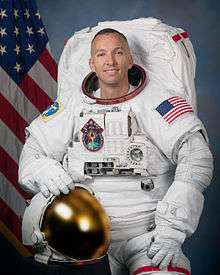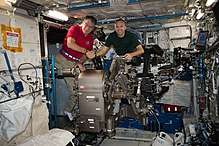Randolph Bresnik
| Randolph James Bresnik | |
|---|---|
 | |
| NASA Astronaut | |
| Nationality | American |
| Status | Active |
| Born |
September 11, 1967 Fort Knox, Kentucky, U.S. |
Other occupation | Fighter pilot, test pilot |
|
The Citadel, B.A. 1989 University of Tennessee-Knoxville, M.S. 2002 | |
| Rank | Colonel, USMC (retired) |
Time in space | 149 days 12 hours 12 minutes |
| Selection | 2004 NASA Group 19 |
Total EVAs | 5 |
Total EVA time | 32 hours [1] |
| Missions | |
Mission insignia |
|
Randolph James "Komrade"[2][3] Bresnik (born September 11, 1967) is an officer in the United States Marine Corps and a NASA astronaut.[4] A Marine Aviator by trade, Bresnik was selected as a member of NASA Astronaut Group 19 in May 2004.[5] First launched to space on STS-129. Served as Flight Engineer for Expedition 52, and as ISS Commander for Expedition 53.[6]
Biography
Bresnik was born in Fort Knox, Kentucky but considers Santa Monica, California to be his hometown.[4]
Bresnik graduated from Santa Monica High School in Santa Monica, California, in 1985.[4] He then earned a Bachelor of Arts degree in Mathematics from The Citadel in 1989, and later a Master of Science degree in Aviation Systems from the University of Tennessee-Knoxville in 2002.[4] He then graduated from the Air War College in 2008. Randy is the first graduate of The Citadel to fly in space.[7]
Bresnik's family includes his wife, Rebecca Burgin of Pompton Plains, New Jersey, a son Wyatt (2006), and a daughter Abigail Mae (2009) who was born while he was in orbit during STS-129. This marked the second time a space traveler became a parent while on orbit; it first happened when Franz Viehböck's daughter was born while he was in space in 1991. His father is Albert 'Randy' Bresnik.[4]
Marine Corps
In May 1989, Bresnik received his commission as a Second Lieutenant in the U.S. Marine Corps from the Naval Reserve Officer Training Corps at The Citadel. After graduation he attended The Basic School (TBS) and Infantry Officers Course (IOC) at Marine Corps Base Quantico, Virginia. Following Aviation Indoctrination and Primary flight training in Pensacola, Florida, he entered Intermediate and Advanced flight training in Beeville, Texas, and was designated a Naval Aviator in 1992.[4]
Bresnik then reported to the Navy Fighter/Attack Training Squadron VFA-106, Naval Air Station Cecil Field, Florida, for initial F/A-18 training. Upon completion of training he reported to Marine Fighter/Attack Squadron, VMFA-212 at Marine Corps Air Station Kaneohe Bay, Hawaii, then MCAS El Toro, California, and additionally MCAS Miramar, California, where he made three overseas deployments to the Western Pacific. While assigned to VMFA-212, he attended the Marine Corps Weapons and Tactics Instructors Course (WTI) and Naval Fighter Weapons School (TOPGUN).[4]
Bresnik was selected for the U.S. Naval Test Pilot School (USNTPS) at NAS Patuxent River, Maryland, and began the course January 1999. After graduation in December 1999, he was assigned as an F/A-18 Test Pilot/Project Officer at VX-23, the Naval Strike Aircraft Test Squadron (NSATS). While at Strike, Bresnik flew the F/A-18 A-D and F/A-18 E/F in all manners of flight test.[4]
In January 2001, he returned to the USNTPS as a Fixed-Wing and Systems Flight Instructor, where he instructed in the F/A-18, T-38 Talon, and T-2 Buckeye. Bresnik returned to NSATS in January 2002 to continue flight test on the F/A-18 A-F as the Platform/Project Coordinator.
In November 2002, he reported to Marine Aircraft Group 11 (MAG-11) as the Future Operations Officer. In January 2003, MAG-11 deployed to Ahmad al-Jaber Air Base, Kuwait. From Al Jaber, he flew combat missions in the F/A-18 with VMFA(AW)-225 in support of Operation Southern Watch and Operation Iraqi Freedom. Bresnik was the Operations Officer of VMFA-232 when he was selected for the astronaut program.
Bresnik has logged more than 6,000 hours on 81 different aircraft.[4]
During his military service he was awarded: Defense Meritorious Service Medal, Meritorious Service Medal, Strike/Flight Air Medal (3), Navy and Marine Corps Commendation Medal with Combat "V" (3), Navy and Marine Corps Achievement Medal (3), Presidential Unit Citation and various other service awards.
NASA career

Bresnik was selected by NASA in May 2004 as an astronaut candidate. He was one of two pilots chosen in the Astronaut Class of 2004.[5] In February 2006, he completed Astronaut Candidate Training.[4] Bresnik participated in the first analogue ESA CAVES mission on September 2011, staying underground and exploring the caves for 6 days, simulating Mars mission technologies.[8][9]
On June 10, 2014, NASA announced that Bresnik would command the NEEMO 19 undersea exploration mission aboard the Aquarius underwater laboratory, which began on September 7, 2014 and lasted seven days.[10][11]
Spaceflight experience
STS-129
In November 2009, he flew as a Mission Specialist on STS-129. He participated in the second and the third spacewalks of the mission. Bresnik's two spacewalks totalled 11 hours and 50 minutes. His wife Rebecca gave birth to their daughter, Abigail Mae Bresnik on 21 November 2009 at 11:04 p.m. CST, while he was on orbit.[12][13]
Expedition 52/53

Bresnik launched aboard Soyuz MS-05 to the ISS on 28 July 2017, and served as Flight Engineer for Expedition 52, and as ISS Commander for Expedition 53.[6]
On October 5, 2017, Bresnik performed his third spacewalk, along with Mark Vande Hei. The spacewalk replaced the gripping mechanism on Canadarm2, the latching end effector A, or LEE-A. Spacewalk duration was 6 hours and 55 minutes.[14] On October 10, 2017, Bresnik and Vande Hei completed the second EVA of the mission. They lubricated the newly installed end effector and replaced cameras, and the duration was 6 hours and 26 minutes. On October 20, 2017, Bresnik and Joe Acaba performed an EVA to continue with the lubrication tasks, and to install more cameras. The duration was 6 hours and 49 minutes.[15]
Bresnik returned to Earth on December 14, 2017. The Soyuz MS-05 landed on 8:38 UTC.[16] The duration of the mission was 138 days, 16 hours, 56 minutes and 37 seconds.[17]
- Spaceflights[18]
| # | Spacecraft launch | Launch date | Mission | Spacecraft landing | Landing date | Duration | Spacewalk times | Spacewalk duration |
|---|---|---|---|---|---|---|---|---|
| 1 | Atlantis STS-129 | 16 November 2009, 19:28 UTC | STS-129 | Atlantis STS-129 | 27 November 2009, 08:38 UTC | 10 days 19 hours 16 minutes | 2 | 11 hours 50 minutes |
| 2 | Soyuz MS-05 | 28 July 2017, 15:41 UTC | ISS-52 / ISS-53 | Soyuz MS-05 | 14 December 2017, 08:38 UTC | 138 days 16 hours 57 minutes | 1 | 06 hours 49 минут |
| 149 days 12 hours 13 minutes | 3 | 18 hours 39 минут | ||||||
References
![]()
- ↑ "EVA info for Astronaut Randolph Bresnik". spacefacets.de. Retrieved September 11, 2017.
- ↑ Chris Gebhardt (November 2, 2009). "Shuttle Program managers outline mission priorities for STS-129". NASASpaceflight.com.
- ↑ "Photo of Bresnik on November 3, 2009, during Terminal Countdown Demonstration Test (KSC-2009-6056)". NASA. November 3, 2009. Archived from the original on June 8, 2011.
- 1 2 3 4 5 6 7 8 9 10 National Aeronautics and Space Administration (2008). "Randolph J. Bresnik (Colonel, USMC)". NASA. Retrieved September 2, 2008.
- 1 2 NASA (February 13, 2006). "Astronaut Class of 2004 (Group 19)". Astronaut Biographies. NASA. Retrieved 2007-04-22.
- 1 2 "NASA Updates 2017 International Space Station Crew Assignments". NASA. 15 November 2016. Retrieved 22 November 2016.
- ↑ Mike Massimino (October 30, 2009). "STS-129 Behind The Scenes". NASA.
- ↑ "Mission accomplished cave crew returns to Earth". ESA. 19 October 2011. Retrieved 13 October 2017.
- ↑ "SPACE in videos: CAVES 2011 MISSION ACCOMPLISHED: CAVE CREW ASTRONAUTS RETURN TO EARTH". ESA. 19 October 2011.
- ↑ "NASA Announces Two Upcoming Undersea Missions". NASA. June 10, 2014. Retrieved June 24, 2014.
- ↑ Bergin, Chris (June 11, 2014). "NEEMO returns with two new underwater missions". NASASpaceflight. Retrieved June 24, 2014.
- ↑ William Harwood (November 11, 2009). "Atlantis astronaut's wife delivers a baby girl". Spaceflight Now.
- ↑ "Baby Born While Astronaut Dad Spacewalks". Associated Press. November 21, 2009. Retrieved 22 November 2009.
- ↑ Harwood, William. "Aging robot arm gets spacewalk surgery". cbsnews. Retrieved October 5, 2017.
- ↑ Whiting, Melanie (October 20, 2017). "Expedition 53 Spacewalk Successfully Comes to an End". NASA.
- ↑ Chris Bergin (December 14, 2017). "Soyuz MS-05 returns crew back to Earth". nasaspaceflight.com.
- ↑ "Expedition 53". spacefacts.de.
- ↑ "Statistics - Bresnik Randolph James". spacefacts.de. Retrieved 2017-12-30.
This article incorporates text in the public domain from the National Aeronautics and Space Administration.
External links
| Wikimedia Commons has media related to Randolph Bresnik. |
- NASA biography
- Astronaut Biography: Randolph Bresnik
- Astronaut Biography: Bresnik
- Randolph Bresnik on Twitter

| Preceded by Fyodor Yurchikhin |
ISS Expedition Commander September 2, 2017 - December 14, 2017 |
Succeeded by Alexander Misurkin |